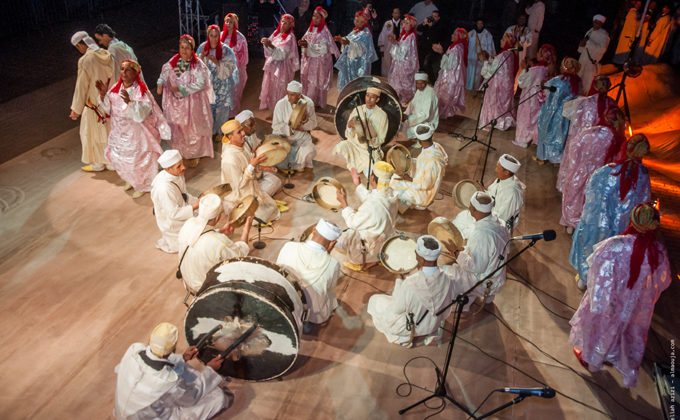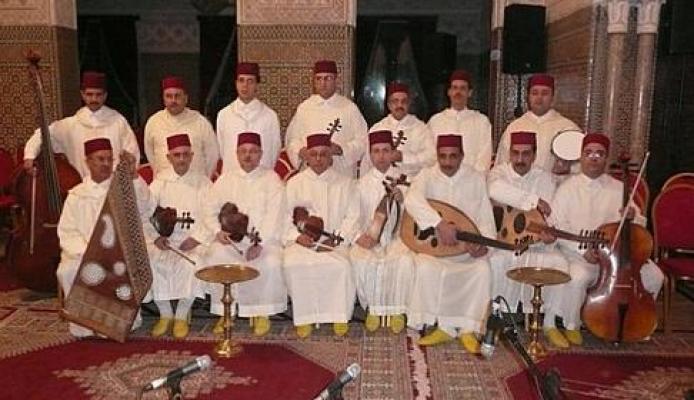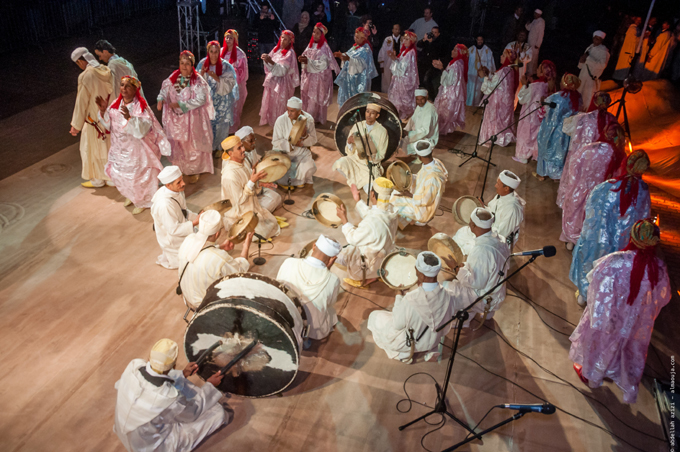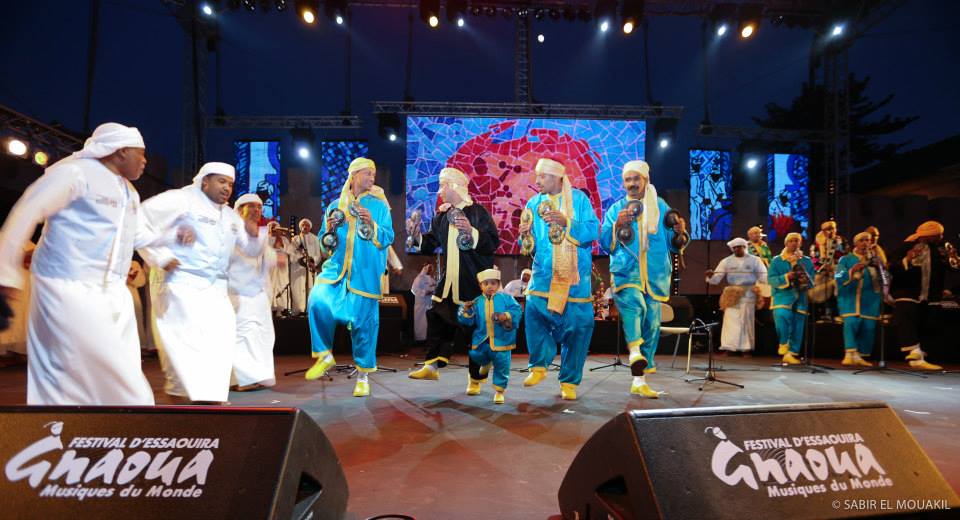
Moroccan music is incredibly diverse, with the predominant sounds and preferences changing from one region to another.
The music you hear throughout Morocco today is influenced by the ethnic groups residing in an area, the area’s history and heritage, and the local culture. These factors all contribute to the rich musical landscape of the country.
The traditions of Moroccan music have endured over time, while also incorporating outside influences in some cases. Music is an integral part of everyday life for many Moroccans, providing pleasure and relaxation.
Certain types of music hold symbolic meaning and are featured prominently in special events and ceremonies. Additionally, there are sounds strongly connected to religious practices.
Here’s an overview of the main types of music around Morocco:
Table of Contents
Andalusian Music: Al-ALA

The style of music most commonly associated with Morocco is Andalusian music. It is prevalent in the north of the country, and it can trace its roots back to the 9th century.
Common instruments that accompany lilting voices include the drum, lute, violin, and tambourine.
Andalusian music is a combination of music from the Moorish areas of Spain and traditional sounds from the Middle East.
When Spain conquered Grenada, many Arabs and Jews fled to North Africa, taking their traditions and musical customs with them.
Combined with traditional Arabian music already present in the area, the result was what is now known as Andalusian music.
Malhun Music
Stemming from Andalusian music, malhun was mainly developed by the craftspeople and artisans of Morocco.
Although developed by traditional tradesmen, the enjoyment of malhun spans all social classes in Morocco today.
A type of sung poetry, malhun does not follow grammar rules, creating some unusual and memorable lines.
Another interesting feature is that it uses Moroccan dialects and everyday speech rather than standard Arabic expressions.
This has led to it being considered an early type of urban music. Malhun retains strong links to the past.
Although usually just using the voice, various types of drums may be used to perform malhun music
Berber Folk Music
Morocco’s population comprises both Arabs and Berbers, with Berbers having called the lands home for a much longer time.
Berber communities are traditionally found in the mountainous areas of Morocco, with different areas having their own distinct sounds and styles of music.
Berber songs often tell folk stories through the lyrics, relaying historic events, beliefs and cultural aspects.
Common instruments include the fiddle, flute, drum, and cymbals, with hand clapping adding to the rhythmic beat that is commonly heard in Berber music.
Music is a major part of significant events in Berber society, including seasonal festivities, weddings, and funerals.
Many communities have a group of locals who specifically perform at major events. Known as imdayzn, the bands are fronted by a poet, known as an amdyaz.

It’s typical for whole villages to come together to celebrate festive occasions, with music and dancing playing a big part of the celebrations.
Traditional dances that accompany music are learnt from a young age, with specific movements and routines performed by the group.
Gnawa Music

Named after a specific ethnic group and with strong historic links to African slaves, gnawa is lively and hypnotic. It tells stories of oppression and restrictions, as well as hope for a free future.
It became representation of all former slaves who had escaped or who had been set free, not just those from the gnawa community.
Similar to other global styles of music that originated within enslaved African communities, gnawa is different to some types due to its strong spiritual connections.
It is used as a way to commune with and praise God, with the gnawa people believing that a person cannot communicate directly with a higher being.
Although traditional moroccan music retains deeply spiritual meanings, gnawa music is reaching more international audiences when it takes on a more secular meaning.
A strong beat is created by the use of basic instruments such as the tbel drum and castanet-like instruments known as grageb, whilst a softer, more haunting, and more mystic sound is added with the lute.
Sufi Music
Sufi music refers to the devotional hymns of Sufis. Sufism is a mystical branch of Islam, with music used in spiritual activities to help followers to reach a trance-like state.
The music if Sufism varies between the different regions of Morocco, with variations even more noticeable when one compares the different groups of Sufis around the world.
All share one common goal, however: to form a closer relationship with God through music. Movements often accompany the sounds, with whirling dances commonly associated with Sufis.
Sufis also use music as a way of therapy and treating people who are sick. The loud music and religious poetry is believed to drive the devil out of a person, the reason often attributed to a person being ill.
Different Sufi brotherhoods around Morocco include the Aissawa, Hamadcha, the Gnaoua, the Jilala, and the Jajouka.
The reed flute and frame drum are commonly used in Sufi music.
Gharnati Music
Gharnati music is similar to Andalusian like music. It is particularly popular in the nation’s capital of Rabat and Oujda, located close to the border with Algeria.
The name of the musical genre comes from the name of the city of Granada in Andalusia.
Instruments used in gharnati include the banjo, mandolin, lute, and a traditional instrument called the kvitra. The piano may also be used nowadays.
Chaabi Music
Chaabi is perhaps the musical style that most visitors will encounter the most as they travel around Morocco.
It plays in cafes and coffee shops, is often the first choice for taxi drivers when they are flicking through their radio channels, many shops play chaabi, and you may hear it coming from people’s homes.
The name translates as “popular” and it combines elements from various other styles of Moroccan music.
Upbeat and uplifting, themes in chaabi music often include love and social issues. Some groups have found themselves in trouble in the past for their politically based and critical lyrics.
As well as being enjoyed in day-to-day life, chaabi is often heard at parties, celebrations, events, festivities, and social gatherings.
It is a crowd-pleaser type of music, a genre that is sure to raise a smile and get people’s feet tapping along.
A variety of instruments are used in chaabi, including drums, hand-held castanet-like clackers called grageb, the stringed instruments of grimbri, oud, the long-necked buzuq, and kamenjah. Modern groups might also add the electric guitar.
Rai Music
Although more commonly associated with neighboring Algeria, Rai music is, nonetheless, popular in some parts of Morocco too.
It is especially common in the eastern areas of Morocco, close to the Algerian border.
The name rai means “opinion”, so it’ll be no surprise to learn that the folk music talks a lot about life, social issues, community challenges, and world problems in its lyrics.
Stylistically, rai blends traditional Berber music with more modern musical instruments. It’s not unusual to hear the lute and drums combined with guitars and synthesized beats.
Reggada Music
Reggada music is a lively and rhythmic folk music style originating from the northern regions of Morocco, particularly from the Rif region.
It is deeply rooted in the cultural heritage of the Amazigh (Berber) people and is characterized by its energetic beats, vibrant melodies, and traditional dance forms.
Reggada music often involves a combination of percussion instruments, such as the bendir and tarija, along with other traditional instruments like the ghaita (oboe) and sometimes modern elements.
Rap Music
Rap is growing in popularity amongst the younger generations in Morocco, with direct lyrics that speak about societal problems and cultural issues.
Young groups of Moroccans might blast rap music on the streets of their neighborhood as they hangout away from their homes.
Moroccan rap music borrows words and phrases from foreign languages, such as French and English, as well as using the language of the Arabs (Arabic) and Berbers (Amazigh).
Instruments of Moroccan Tarab (Authentic)
The world of Moroccan music is adorned with a rich tapestry of diverse instruments, each with its own unique story and role. Among the instruments that weave the tapestry of Moroccan tarab, we find:
Kamenjah(Violin)
The Kamenjah is significant in Moroccan music as it has evolved in the culture, resembling the violin or cello with its own unique characteristics.
Traditional Kamenjah has three strings, though modern ones may have four. Notably, its distinct playing style involves holding it vertically on the knee and using sideways bowing, unlike the classical violin approach.
Guembri
Standing at the heart of Moroccan music is the guembri, also known as sintir.
This bowed string instrument resonates alongside the soulful chants of Gnawa singers. Crafted from cedar wood and adorned with goat skin, the guembri possesses a profound resonance
Bendir
The bendir is a circular frame drum with goat skin stretched over one side, deeply ingrained in Moroccan music and culture.
Played by hand, its resonant beats are a vital component of traditional genres, religious ceremonies, and cultural festivities, enriching Morocco’s musical landscape with its distinctive and captivating rhythms.
Darbouka
The darbouka, a classic hand drum with a goblet shape, holds a significant place in Moroccan music. Its versatile tones, from deep bass to sharp highs, make it essential in various contexts.
It’s prominent in Middle Eastern, classical, Andalusian, and chaabi (Moroccan pop) music. While less common in folk styles, the darbouka’s sturdy design and adaptable sound have made it a practical choice
Tarija
The Tarija, a Moroccan hourglass-shaped percussion instrument, boasts intricate craftsmanship with its glazed pottery body and goatskin drumhead.
Its unique sounds, enhanced by internal snares and finger snaps, contribute to Morocco’s musical heritage. Its aesthetic charm is elevated by colorful Moroccan patterns, reflecting the nation’s cultural vibrancy.
Moroccan Music Events
Morocco is home to a vibrant music scene, with numerous festivals and events held throughout the year. Additionally, various restaurants and centers regularly showcase the diverse styles of Moroccan music through folk shows.
Simply wandering around the bustling centers of cities like Marrakech, particularly Djemaa el-Fna, will treat you to impromptu performances by talented individuals and groups.
One of the notable festivals is the International Gharnati Festival, held annually in Oujda during June. This event celebrates the rich tradition of Gharnati music.
Another must-see festival is the Gnaoua World Music Festival, a four-day extravaganza held in the coastal town of Essaouira. One of its attractions is that many performances are free for all to enjoy.
For those visiting Marrakech in July, the acclaimed National Festival of Popular Arts offers a multitude of performances throughout the city. This festival not only showcases musical performances but also highlights other traditional arts and cultural aspects, providing a comprehensive experience.
Rabat hosts Mawazine, one of the largest music festivals in the world. This festival features an impressive lineup of both local and international performers across seven stages, with nearly 100 different acts gracing the event.
Meanwhile, the Timitar Music Festival in Agadir focuses on promoting Berber music and preserving the traditions of Morocco’s Berber people.
Other notable musical events in Morocco include the ten-day Festival of World Sacred Music in Fes, the Merzouga International Music Festival, the dance festival of Oasis, Tanjazz, and the Sufi Festival. These events cater to diverse musical tastes and offer a range of genres and styles.
While Moroccan music holds a special place in the hearts of its people, there is also a growing interest among younger generations in international music. Popular artists from the USA, Canada, the UK, France, and Spain find a significant following in Morocco.
In clubs and other venues, you’ll find a lively atmosphere with dance and pop tunes. Additionally, genres like soulful rock, retro sounds, electronic music, reggae, hip-hop, jazz, indie, and blues enjoy popularity.
However, genres such as metal, grunge, and punk are not as widely embraced, with many people preferring styles that steer clear of harsh sounds and angry lyrics.
In Morocco’s music, tradition and innovation converge. From timeless Andalusian harmonies to modern hip-hop rhythms, the country’s soundscape is a mosaic of diversity.
As you explore this melodic journey, you’re immersed in more than just tunes – you’re traversing history and culture. Each genre reveals Morocco’s spirit, blending its heritage with contemporary beats.
Let the melodies be your guide through Morocco’s narrative. This musical mosaic echoes stories of the past while resonating with the vibrant pulse of today.